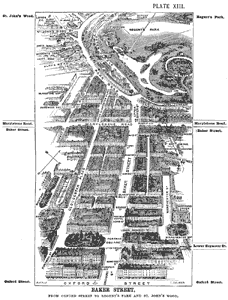Arthur Conan Doyle
Like the elusive Sherlock Holmes, his most famous creation, Sir Arthur Conan Doyle was a man of many contradictions. Scientifically educated, he believed in sťances and fairies. An advocate for more equitable divorce laws, he believed that women should be denied the vote. A humanist who identified with oppressed peoples, he staunchly defended English colonialism at its most aggressive. He dreamed of being a serious historical novelist, yet he is best remembered for stories that he considered pot-boilers. The product of a pragmatic, fiercely protective mother and a detached dreamer of a father, Conan Doyle became a man with astonishing self-confidence, a tireless self-promoter who also retained some measure of childish innocence throughout his life.
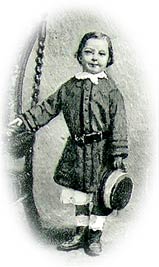 |
Arthur Conan Doyle
at 4 years old |
Arthur Conan Doyle's humble beginnings did not predict his future success. Born on May 22, 1859, to a middle-class, Catholic family, he grew up on Edinburgh's rough-and-tumble streets, far from his successful grandfather and uncles, who hobnobbed with London's intellectual elite. His celebrated grandfather, John Doyle, had reinvented the art of political caricature. John Doyle's eldest son, also named John, became a well-known caricaturist himself, and the second son, Richard, began his career as a successful cartoonist for Punch (an early magazine devoted to political satire) and ended it as a famous book illustrator. Two other sons were also successful in different fields.
Arthur's parents, Mary Foley Doyle and Charles Altamont Doyle, had moved to Scotland from London, hoping that Charles could advance his career in architecture. Having inherited some measure of his family's artistic talent, Charles began with every hope of success, but never realized his dreams. Plagued by depression and alcoholism, Charles was a distant father and husband, becoming so detached from reality that he ended life in an asylum. With considerable charity, his son Arthur later said of him, "My father's life was full of the tragedy of unfulfilled powers and of underdeveloped gifts."
As the only active parent, Mary
Doyle had a strong influence on Arthur, the eldest surviving son
of seven children, instilling in him a love of chivalric romances
and a firm belief in the English code of honor. She made the boy
memorize and recite his family's genealogy, ancestor by ancestor.
When left to himself, Arthur loved to read American "wild west"
adventure stories, especially those of Bret Harte and Thomas Mayne
Reid, an Irish immigrant to the U.S. who wrote The Scalp Hunters
(1851), young Arthur's favorite book. As an adult, Conan Doyle felt
that the highest vocation he could pursue as a writer was to create
well-researched historical romances idealizing British history.
The Doyles sent Arthur to an austere Jesuit school for his early
education. Despite the Spartan fare and harsh discipline, Arthur
excelled. When Arthur left the Jesuits, Mary Doyle persuaded him
to pursue a medical degree at the University of Edinburgh. Arthur
agreed, more out of a practical desire for a reliable profession
than out of passion for the subject.
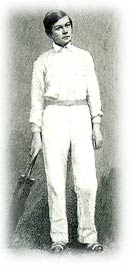 |
| Arthur at 14 holding
|
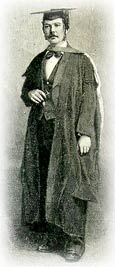 |
The medical school
graduate at 22 |
By this time, Charles Doyle had lost his job, and the family had difficulty paying the school fees. A lodger named Bryan Charles Waller became the family's protector, eventually supporting Mary, Charles, and their children completely.
 |
Dr. Joseph Bell |
Once at university, Conan Doyle found the work difficult and boring. He gained more amusement from playing sports, at which he excelled, than in listening to lectures in large, crowded lecture halls. More interesting than studying was describing his instructors' eccentric personalities. Among his teachers was the man Conan Doyle later acknowledged as his inspiration for Sherlock Holmes, Dr. Joseph Bell. Dr. Bell taught his students the importance of observation, using all the senses to obtain an accurate diagnosis. He enjoyed impressing students by guessing a person's profession from a few indications, through a combination of deductive and inductive reasoning, like Holmes. Although Bell's methods fascinated Conan Doyle, his cold indifference towards his patients repelled the young medical student. Some of this coldness found its way into Sherlock Holmes's character, especially in the early stories.
Around the time he obtained his medical degree,
Conan Doyle's crisis of faith, which had been brewing since his
days with the Jesuits, came to a head. He announced to his uncles
that he had turned away from organized religion, shocking them deeply
and causing them to withdraw their support. Because he refused to
practice his family's religion, Conan Doyle was forced to make own
way in the medical profession, with neither financial help nor letters
of introduction to influential people. He was an uneasy agnostic,
however, and although he hoped that pure rationalism could take
the place of religion for him, it never did. Around 1880, he began
to attend sťances, and by the end of his life he had become an ardent
spiritualist.
A restless man who loved adventure and physical activity, Conan
Doyle took any opportunity to travel. He grew interested in photography
and published several articles about it. To make a few extra pounds
while studying medicine, he hired on as ship's doctor on brief voyages
to the Antarctic and Africa. He also began to write short stories
for sale, based on the adventure tales he had loved as a child and
on his own first-hand experiences. After graduation, he struggled
to establish a medical practice, since he could not afford to buy
one. Although hampered by poverty and his lack of social connections,
Conan Doyle achieved a modest success in medicine. His 1885 marriage
to Louise Hawkins, the sister of a patient who had died, provided
him with a small supplemental income that raised his standard of
living.
 |
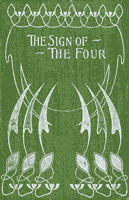 |
In 1886, Doyle finished the first Sherlock Holmes
novella, A Study in Scarlet. After several rejections,
he was forced to sell it outright for £25 for inclusion in
the 1887 Beeton's Christmas Annual, a holiday collection that often
sold out, but did not usually attract much attention in the national
press. The work was reprinted in 1889 and many more times, but Conan
Doyle never earned another penny from it. Sign of the Four,
the second work to feature Holmes and Watson, also achieved a small,
but by no means brilliant, success.
While writing the early Holmes stories, Doyle also began what he considered his most important work: chivalric, historical novels based on British history, primarily, Micah Clark, Sir Nigel, and The White Company. Although these novels were widely admired, none of them created the stir caused by the first series of short stories featuring Sherlock Holmes and John Watson that appeared in The Strand Magazine, starting in 1891. Despite their overwhelming success, Conan Doyle never suspected that these stories would be the foundation of his literary legacy.
 |
Arthur Conan Doyle in
1891, the year Holmes made him a celebrity |
After writing three series of twelve Holmes stories,
receiving the unheard-of sum of £1000 for the last dozen, Conan
Doyle was sick to death of the popular detective and decided to kill him
off in the 1893 story, "The Final Problem." Conan Doyle considered the
Holmes stories light fiction, good for earning money, but destined to
be quickly forgotten, the literary equivalent of junk food. "I couldn't
revive him if I would, at least not for years," he wrote to a friend who
urged Holmes's resurrection, "for I have had such an overdose of him that
I feel towards him as I do towards pâté de foie gras,
of which I once ate too much, so that the name of it gives me a sickly
feeling to this day." The vehement public reaction to Holmes's death must
have shocked Conan Doyle. People wore black armbands and wrote him pleading--or
threatening--letters. Still, it was nine years before he capitulated to
public opinion and brought Holmes back.
The third Holmes novel, The Hound of the Baskervilles, appeared
in nine parts in The Strand Magazine during 1901-2, but it was
presented as an old case from Watson's records, completed before Holmes's
death. Conan Doyle did not make up his mind to resurrect Holmes until
1903, when he wrote "The Empty House." He continued, reluctantly, to produce
Holmes stories until 1927, three years before his own death.
Conan Doyle became an important public figure, twice standing (unsuccessfully)
for Parliament. He was knighted for his efforts on behalf of the Boer
War, both as the author of a persuasive, pro-war book and as a volunteer,
caring for wounded British soldiers in the field. He even took on several
real-life mysteries, using Holmes's methods and his own status as a famous
author to free two unjustly imprisoned men.
The First World War tore apart Conan Doyle's familiar world. Like so many
others, he lost close family members to the conflict. Conan Doyle's brother-in-law
and nephew died in combat, while the influenza pandemic took his brother
Innes and his eldest son Kingsley, weakened by war wounds. During the
war, he managed to have himself appointed as an observer for the Foreign
Office, but he was kept away from the horrors of the western front for
fear that he might reveal to the public things that the military would
rather have kept quiet. Even Sherlock Holmes served England in the war.
In the story that Conan Doyle intended to be the last Holmes outing, His
Last Bow, published in 1916, Holmes outwits a German spy.
Conan Doyle found a refuge from the horrors of the war, and he clung to
it tenaciously. Starting in 1916, he publicly declared himself a spiritualist,
and over the next few years he made spiritualism the center of his life,
writing on the subject and traveling all over the world to advocate his
beliefs. Never afraid to take an unpopular stand, Conan Doyle wrote a
book in 1922 called The Coming of the Fairies, in which he defended
the veracity of two young girls who claimed to have photographed each
other playing with actual fairies and goblins.
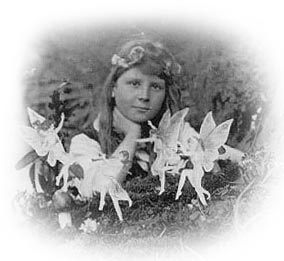 |
Frances Griffiths
and "friends" |
Towards the end of their lives, long after Conan Doyle's death, the aged "girls" admitted to having used paper cutouts as stand-ins for the fairies. Interestingly, Conan Doyle's own Uncle Richard had invented, in his book illustrations, the typical representation of a fairy as a little girl with dragonfly wings and a gossamer gown. No matter how many times Conan Doyle was tricked by mediums later proven to be dishonest, he continued to believe in spiritualism. The famous American magician Harry Houdini made a project of trying to convince Conan Doyle of his error, but all he managed to do was ruin their friendship. Houdini saw spiritualism as cruel because it gave people false hope; Conan Doyle, who was already suffering from serious heart disease, wanted to believe that death was a grand new adventure. He fought his infirmity, trying to continue writing and traveling as before. He died at the age of 71, secure in his spiritualist beliefs.
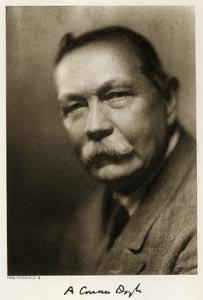 |
Conan Doyle in
the last year of his life |
Doctor, writer, believer in the supernatural--Conan
Doyle's personality encompassed all these traits that contributed to the
Sherlock Holmes stories we love to read today. Conan Doyle's fanciful
imagination, combined with his scientific training, created ideas that
have helped to shape the modern mystery and science fiction genres. One
of the first to anticipate the dangers of submarines in warfare, he wrote
a Sherlock Holmes story on the subject. His novel The Lost World
is the ancestor of Jurassic Park and countless other films. Another
of his stories, "The Ring of Thoth," was probably the plot source of the
1932 film The Mummy with Boris Karloff. An 1883 medical article
called "Life and Death in the Blood," outlining the imaginary voyage of
a microscopic observer through the human body, anticipated the main idea
behind the film Fantastic Voyage. Conan Doyle's most long-lived
idea, however, was Sherlock Holmes himself, who has continued to evolve
in our time through the works of other writers and filmmakers, taking
forms even his creator could never have imagined.
Sherlock Holmes: A Hero for His Time--and Ours
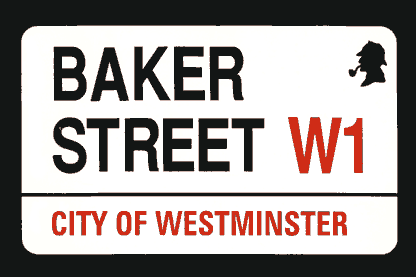 |
Street signs on Baker Street, Westminster |
As a Halloween costume, it's almost too easy--just
wear a deerstalker cap, stick a calabash pipe between your teeth,
and carry a magnifying glass. Say, "Elementary, my dear Watson."
Chances are, everyone will know that you're supposed to be Sherlock
Holmes. No matter that Holmes wore a cap only once in the original
stories, that his pipe of choice was not a calabash, and that he
never uttered that phrase. He did, however, use a magnifying glass
occasionally.
Like other pop culture icons, Holmes and Watson have evolved since
their creation over a century ago. Their characters have changed,
as have the qualities for which audiences admire them. Below appear
some of the best-known permutations of Holmes and Watson, as they
have traveled from print to stage and radio, to film and television,
and back to print again. It would be impossible to list every version
here, so some guidelines have been included for further investigation.
The game is afoot! Happy sleuthing.
The Many Faces of Holmes
The original readers of the very first Holmes story, A Study
in Scarlet, had to do with four lackluster illustrations by
D.H. Friston, but, when the novella was published in book form,
Holmes looked something like Arthur Conan Doyle's own father, Charles
Altamont Doyle--and was, in fact, the elder Doyle's creation. The
author's father created a series of vague line-drawings that unfortunately
failed to capture the excitement of the text. He gave Sherlock Holmes
his own features, including his scraggly beard. No record exists
of his son's response.
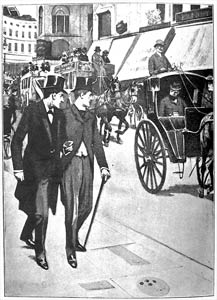 |
Holmes and Watson
on the town |
When "A Scandal in Bohemia" was published in The
Strand Magazine in 1891, readers were greeted with Sidney Paget's
moody drawings, which represent Holmes as tall, handsome, and elegant,
despite Conan Doyle's original description, according to which Holmes
was extremely thin, with a large nose and small eyes set close together.
Apparently Paget's younger brother Walter, whom the artist used
as a model, was quite a handsome fellow. Years later, after his
brother's death, Walter himself illustrated a few of Conan Doyle's
stories in The Strand.
Conan Doyle soon grew attached to Sidney Paget's elegant vision
of Holmes, and when he met the American actor William Gillette,
who wanted to play Holmes on the stage, he felt that his creation
had come to life. Pictures of Gillette as Holmes, wearing the famous
dressing gown, can be found at the "221B Baker Street" website (ed.
Sherry Franklin): www.sherylfranklin.com/sh-gillette.html.
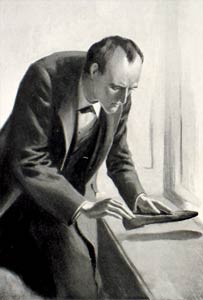 |
Holmes is balding
in J. Frank Wiles's illustration from The Valley of Fear |
Others, such as the American illustrator Frederic
Dorr Steele, who based his Holmes on William Gillette, also created
a compelling vision of the detective and his world. Holmes usually
remained tall and thin, but not always young or handsome.
Holmes and Watson were well-represented on the radio, too. See "The
Sherlock Society of London" website for a list of radio plays (including
some stories not written by Conan Doyle) that can be downloaded
in MP3 format: www.sherlock-holmes.org.uk/radio.php.
Later radio versions with John Gielgud as Holmes, Ralph Richardson
as Watson, and Orson Welles as Professor Moriarty, can be found
on the "Valley of Fear" website: www.cambridge-explorer.org.uk/HBWEB/VV341/JG-RR-Home.htm
(ed. Hugo Brown).
Holmes in Film
During Conan Doyle's lifetime, silent film versions of the Sherlock
Holmes stories were made in England and the U.S. In the U.S, John
Barrymore played Holmes in a film based on one of Gillette's stage
plays, and British actor Ellie Norwood played Holmes in 47 silent
films between 1920 and 1923. Typing "Sherlock Holmes" into the search
engine of the "Internet Movie Database" at www.imdb.com
will retrieve hundreds of titles, including drama, comedy, pastiche,
cartoons, and all sorts of other stories that borrow the characters
of Holmes and Watson.
"Gaslight on the Web" contains links to a photo gallery of some
of the many actors who played Sherlock Holmes on the stage and in
film: www.mindspring.com/~tjbayne4/photogl.htm
(ed. Tom Bayne). "Sherlockian.net" also maintains links to sites
about actors who portrayed Sherlock Holmes on radio, TV, film, and
stage: www.sherlockian.net/stage/index.html
(ed. Chris Redmond).
The two best-known Holmes of our time are probably Basil Rathbone
and Jeremy Brett. Rathbone played Holmes alongside Nigel Bruce,
as a rather doddering Watson, in 14 films between 1939 and 1946;
some were filmed adaptations of Conan Doyle's stories, while others
used newly created plots. In the 1980's, Jeremy Brett acted opposite
two excellent Watsons, David Burke and Edward Hardwicke, in 36 episodes
and four films produced by Granada Television in England and shown
on PBS. Most are available on DVD.
Further Adventures
Search for "Sherlock Holmes" on any internet bookseller's site,
and thousands upon thousands of titles will appear. Since Conan
Doyle's time, writers have been tempted to create their own tales
using Holmes as inspiration. Every Holmes is different. Some authors
concentrate upon Holmes's drug addiction or have him meet a famous
historical figure (Nicolas Meyer's The Seven-Percent Solution
does both). Some focus on his relationship with Watson, while others
invent a lady-friend for him or choose a female acquaintance from
the books to be his paramour. Sometimes Moriarty returns, sometimes
Holmes's brother Mycroft. Occasionally Holmes acquires offspring.
In the past two years alone, at least two dozen novels or short
story collections have come out, not to mention several new editions
of the original works.
Here are some recent fictional treatments: Caleb Carr's The Italian
Secretary (Carroll & Graf, 2005) takes Holmes and Watson into
the realm of the supernatural. In Mitch Cullin's A Slight Trick
of the Mind (Nan A. Talese, 2005), Holmes is in his nineties
and has become rather forgetful. Laurie King's series (published
by Bantam) portrays an aging, but still vital, Holmes and his young
wife. Thos. Kent Miller in The Great Detective at the Crucible
of Life (Wildside Press, 2005) involves Holmes in a Rider Haggard
story in Africa, and Sherlock Holmes and the Search for Excalibur
(Authorhouse, 2005) winds up a trilogy by Luke Steven Fullenkamp
in which Holmes and Moriarty seek the famous sword. (If that seems
far-fetched, consider this: in a 1958 short story called "The Martian
Crown Jewels," science-fiction author Poul Anderson sent Holmes
to Mars.) Some authors focus on Mrs. Hudson, Holmes and Watson's
faithful landlady, or on other minor characters. Others stay busy
figuring out what Holmes did during those years between "The Final
Problem" and "The Empty House," when Watson thought him dead.
For those who want to return to the source, a new version of the
original writings is now available: The New Annotated Sherlock
Holmes has come out in three volumes, two for the short stories
and a third for the novels. It is edited by Leslie S. Klinger and
published by Norton. One caveat: the notes and commentary all play
"the Grand Game," and assume that Holmes and Watson were real people.
The Grand Game
What do we really know about Holmes? Who is he? Where was he born,
who were his parents, where did he go to school? Is he English?
French? American? These questions are irrelevant, you might argue,
because we know that Holmes is a literary character, not a real
person. A large group of dedicated people from all over the world
might not agree. They call themselves Sherlockians, and they play
at "the Grand Game," according to which Holmes and Watson are real
people and Conan Doyle is their rather incompetent literary agent.
In 1912, Ronald A. Knox, a detective-story writer and Catholic priest,
wrote an article called "Studies in the Literature of Sherlock Holmes,"
in which he satirized the ponderous jargon of literary criticism.
The article's assumption that Sherlock Holmes was a real person
caught the fancy of writer and editor Christopher Morley, who formed
a Sherlockian club called the Baker Street Irregulars that continues
to meet today. Their website can be found here: www.bakerstreetjournal.com.
Other Sherlockian societies with their own publications also exist
and can be found on the web.
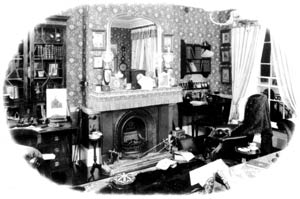 |
The Sherlock Holmes Museum in Meiringen, Switzerland, claims to be the most authentic
Baker Street reproduction in the world |
Conan Doyle wrote the Holmes stories quickly, never imagining that they would receive much scrutiny. If he forgot a date or fact from a previous story, he forged ahead without looking it up. This bad habit has resulted in some startling discrepancies. Was Watson wounded in the leg or the arm? How could Watson's deceased wife be on a visit to her mother's? Is Watson's given name "James" or "John"? To correct these and other inconsistencies, Sherlockians comb the "canon," or "sacred writings," for clues, seek secondary sources (inventing some themselves when all else fails), and write "scholarly" articles, using Holmes's methods to solve contradictions in the works or following clues to add new "facts" to Holmes's and Watson's biographies.
When
this map was drawn in 1892, no 221b Baker Street existed
|
One favorite Sherlockian controversy centers on the "original" location of 221b Baker Street, a non-existent address in Conan Doyle's time. When Baker Street was renumbered during the 1920s, 221b was created on the block formerly called Upper Baker Street. Many faithful representations of the sitting room at 221b Baker Street have been constructed throughout the world. All contain the violin, the tobacco-holding Persian slipper, and other Holmesian accouterments mentioned in the stories.
The Game is played seriously, but is played best when it avoids pomposity. Christopher Morley once wrote, "What other body of modern literature is esteemed as much for its errors as its felicities?" Conan Doyle, on the other hand, wondered why anyone "should spend such pains on such material." He alone, it seems, was immune to the fascination exerted by Sherlock Holmes and John Watson on generations of readers.
